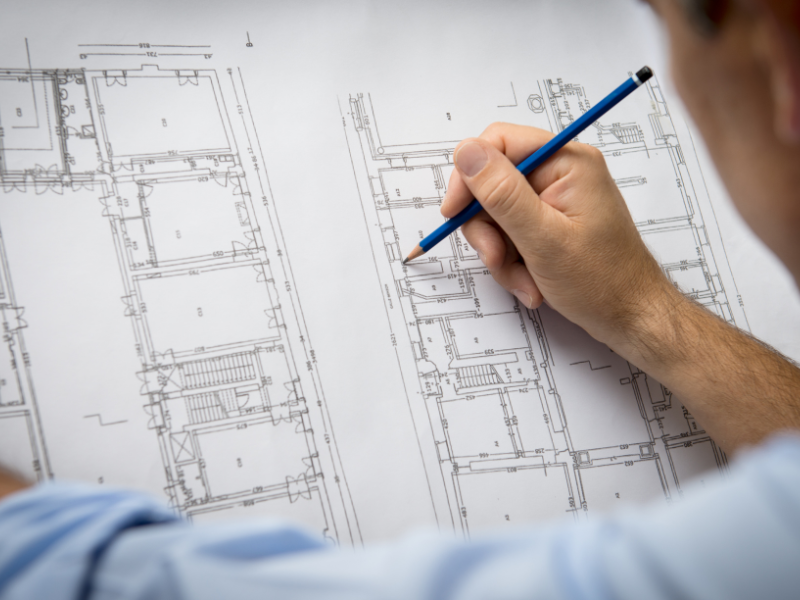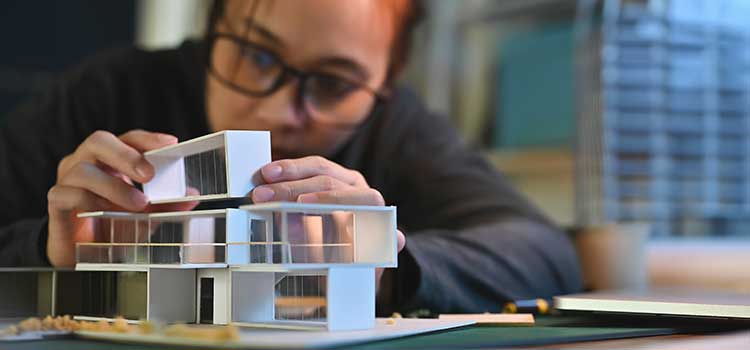Architect Portfolio Tips for Standing Out in the Industry
Comprehending the Diverse Job Paths Available for Aspiring Architect
As an aspiring Architect, you have a globe of job courses waiting on you. Each course uses special challenges and chances to use your imagination and technical expertise. Whether you're drawn to conventional architecture or the subtleties of sustainable layout, there's a specific niche that lines up with your rate of interests. Comprehending these diverse alternatives can form your professional journey, however which instructions will you pick to check out initially?
Typical Style: Designing Structures and Frameworks
Conventional style focuses on developing buildings and frameworks that blend performance with aesthetic appeal. Your styles can mirror cultural heritage, showcasing local customs while fulfilling modern-day needs.
You'll establish skills in composing, model-making, and website analysis, permitting you to imagine and interact your concepts successfully. Engaging with customers, you'll need to recognize their vision and translate it into practical styles.
Moreover, building codes and sustainability methods are crucial in your work, ensuring your structures are secure and eco friendly. As you expand in your career, you'll find possibilities in domestic, business, and even remediation jobs, each offering unique difficulties. Embracing traditional architecture leads the way for a fulfilling job that pays homage to the past while shaping the future.
Urban Preparation: Forming Areas and Public Spaces
As a hopeful Architect, you can play an important function as a metropolitan planner, transforming exactly how neighborhoods connect and work. By utilizing community involvement strategies, you'll guarantee that homeowners have a voice in shaping their atmosphere. And also, incorporating lasting layout concepts will certainly help develop rooms that not only meet today's demands but additionally secure the future.
Function of Urban Planners
While several may think about engineers as the single enthusiasts behind buildings, metropolitan organizers play a vital function in forming the wider landscape of neighborhoods and public spaces. They assess land use, zoning regulations, and area requires to produce sustainable atmospheres that improve top quality of life. By teaming up with different stakeholders, you'll aid design parks, transportation systems, and suburbs that promote social communication and access. Urban coordinators additionally concentrate on environmental factors to consider, making certain that growths integrate green areas and assistance biodiversity. Your experience in spatial design and community characteristics allows you to imagine future growth while preserving cultural heritage. In this crucial function, you'll directly influence how individuals experience their environments, making every project an opportunity for favorable change.
Area Interaction Approaches
Effective neighborhood interaction methods are crucial for urban coordinators to assure that the voices of homeowners are heard and valued in the planning procedure. To cultivate significant discussion, you need to focus on open discussion forums and workshops where community participants can share their ideas and problems. By proactively incorporating and paying attention responses, you'll produce spaces that reflect the community's requirements, inevitably leading to more successful and sustainable city atmospheres.
Lasting Layout Concepts
When designing urban spaces, including sustainable design principles is critical for producing environments that prosper both environmentally and socially. You need to begin by focusing on energy performance, utilizing products that lower waste and advertise recycling. Think about integrating eco-friendly rooms, like parks and yards, to boost biodiversity and boost air high quality. Advertising walkability and public transportation can decrease dependence on autos, promoting a much healthier community.
Designing with water preservation in mind is likewise vital-- consider rainfall gardens and permeable surface areas to handle stormwater. Involving community members throughout the preparation procedure assurances that the rooms you develop meet their demands and encourage social communication. By embracing these concepts, you'll add to lively, lasting urban landscapes that profit everyone.

Landscape Architecture: Developing Sustainable Exterior Environments
As you explore landscape architecture, you'll uncover important layout concepts that create functional and gorgeous outside rooms. Sustainable methods play a vital role in guaranteeing these settings flourish while minimizing environmental effect. And also, you'll find a selection of occupation chances that allow you to make a genuine distinction in just how individuals communicate with nature.
Layout Principles in Landscape
Comprehending design principles in landscape design is vital for producing lasting outdoor atmospheres that balance with nature. You'll need to consider aspects like proportion, range, and balance to ensure your designs feel cohesive and welcoming. Additionally, pay interest to seasonal adjustments, designing with products that complement the surroundings year-round.
Lasting Practices Summary
Sustainable practices in landscape architecture not only concentrate on visual appeals however additionally focus on ecological health and resource conservation. By integrating indigenous plants, you enhance biodiversity and decrease the demand for chemical fertilizers and pesticides. Executing reliable watering systems helps conserve water and reduces runoff, shielding close-by environments. You can create rooms that advertise dirt wellness, such as exercising and utilizing natural products permaculture concepts. In addition, including green framework, like rainfall yards and permeable pavements, help in stormwater administration and minimizes metropolitan heat. When you produce outdoor environments with sustainability in mind, you add to a much healthier earth and provide rooms that foster neighborhood connection. Ultimately, these practices assure your styles profit both individuals and the atmosphere for many years to find.
Occupation Opportunities Expedition
With a strong structure in sustainable methods, landscape architecture offers a selection of occupation courses that allow you to make a meaningful influence on the atmosphere. You might function as a landscape designer, creating visually pleasing and practical exterior rooms, or focus on eco-friendly repair, assisting to restore broken communities. Urban coordinators commonly team up with landscape designers to produce green areas in metropolitan settings, boosting city livability. If you're enthusiastic about education and learning, consider coming to be a landscape design educator, inspiring future generations. Furthermore, you might deal with nonprofits focused on environmental sustainability or take part in research study to innovate new techniques. Each course Architect not just shapes beautiful environments yet likewise promotes a much healthier planet for future generations.
Lasting Layout: Concentrating On Eco-Friendly Practices
As you explore your career in design, embracing environment-friendly techniques can set you apart in a competitive field. Sustainable layout focuses on creating buildings that decrease ecological influence while improving owner well-being. By incorporating renewable materials, energy-efficient systems, and lasting structure techniques, you'll add to a greener future.
Beginning by obtaining knowledge of green qualifications like LEED or BREEAM, which can boost your credentials. Consider just how all-natural light, ventilation, and thermal effectiveness can enhance style. Work together with designers and ecological specialists to innovate options that lower waste and conserve sources.
Do not neglect the importance of community involvement-- appealing regional stakeholders can motivate styles that balance with the setting. As customers significantly focus on sustainability, your experience in green methods will certainly not just draw more info in projects yet likewise accomplish your interest for liable style. Accept this crucial aspect of the occupation, and enjoy your job flourish.
Historic Conservation: Securing and Restoring Social Heritage
While you commence on your architectural trip, think about the vital duty of historical preservation in preserving our cultural heritage. This area concentrates on the defense and repair of significant structures, websites, and frameworks that inform the stories of our past. By engaging in historic conservation, you'll assist guard the architectural heritage that forms community identity.
As a historical preservation Architect, you'll analyze historical significance and examine the condition of frameworks. You'll work carefully with preservationists and historians to assure authentic restoration techniques are utilized. This occupation course permits you to blend creative thinking with research, enabling you to design options that appreciate initial products and workmanship.
Your work not only contributes to sustainability by reusing existing buildings but additionally cultivates a feeling of pride within communities. Welcoming this path will certainly help you end up being a guardian of history, protecting the stories and aesthetic appeals that improve our lives.
Interior Design: Enhancing Indoor Spaces
Historic conservation and interior style both share a dedication to enhancing the constructed setting, but they concentrate on various facets. While historic preservation highlights maintaining a structure's cultural and historical worth, indoor style absolutely nos in on optimizing indoor areas for capability and looks.
As an aspiring Architect, you'll locate that indoor design allows you to blend imagination with technical skills. You'll develop rooms that not just look good but likewise advertise comfort and effectiveness. This field involves comprehending exactly how light, shade, and products interact within a room, influencing state of mind and functionality.
You'll deal with numerous projects, from domestic homes to industrial workplaces, guaranteeing that each atmosphere meets the requirements of its residents. By prioritizing user experience, you can transform interiors right into useful and inspiring spaces, making a substantial impact on how individuals communicate with their surroundings. Embrace the opportunity to boost indoor atmospheres and form the method people function and live.
Industrial Layout: Merging Functionality With Looks
Commercial layout plays a necessary role in creating items that perfectly mix looks with functionality, guaranteeing that what you utilize everyday is not just visually appealing yet likewise practical. As a hopeful Architect, you could engage yourself in this field, concentrating on creating everything from furnishings to consumer electronic devices. Your work entails recognizing customer demands, materials, and manufacturing procedures, enabling you to produce cutting-edge solutions that improve everyday experiences.
In commercial layout, you'll often work together with suppliers, designers, and marketing experts, making certain that your designs are not only gorgeous but also feasible. This career course uses a dynamic environment where creativity fulfills usefulness, making it a satisfying option for architects interested in forming the items of tomorrow.
Often Asked Questions
What Educational Certifications Do I Need to Come To Be a Designer?
To come to be an engineer, you'll need an expert level in architecture, commonly a Bachelor's or Master's. In addition, you'll need to complete an internship and pass the Architect Enrollment Exam to exercise legitimately.
Are There Accreditation Requirements for Different Building Job Paths?
Yes, there're qualification demands for different building paths. Architect. You'll require to pass exams, full teaching fellowships, and occasionally go after specialized training, depending upon your picked focus, like landscape design, city style, or historic conservation
What Software Application Abilities Are Necessary for Architects Today?

Just How Can I Gain Practical Experience While Researching Style?
You can obtain practical experience by interning at get more info building firms, joining design competitions, offering for area jobs, or working together with schoolmates on real-world projects. These opportunities improve your abilities and construct useful links in the market.
What Job Opportunities Exist Outdoors Typical Design Firms?
You can explore different work chances outside typical design companies, like metropolitan planning, interior style, landscape design, construction management, genuine estate growth, or perhaps functions in sustainability consulting. Each deals one-of-a-kind difficulties and incentives.
Whether you're attracted to traditional design or the subtleties of sustainable design, there's a specific niche that straightens with your passions.When designing city spaces, incorporating sustainable layout concepts is crucial for producing settings that flourish both ecologically and socially.As you explore landscape design, you'll find essential style principles that develop beautiful and practical exterior rooms.Recognizing style concepts in landscape architecture is essential for creating lasting outdoor settings that integrate with nature.In industrial design, you'll often team up with marketing professionals, producers, and engineers, guaranteeing that your styles are not only gorgeous yet additionally possible.